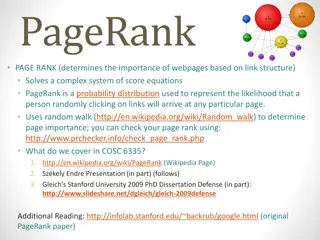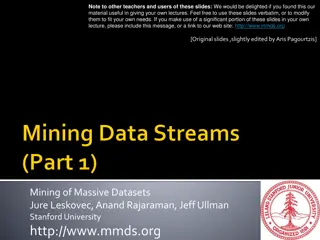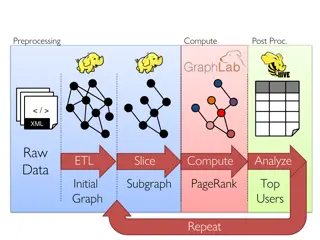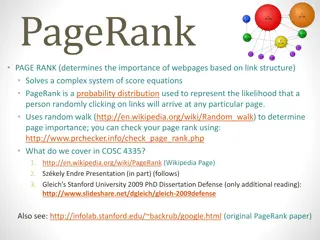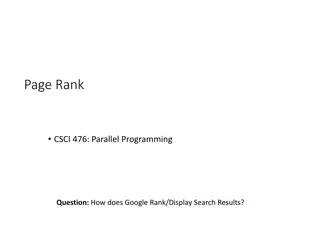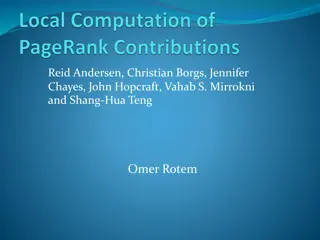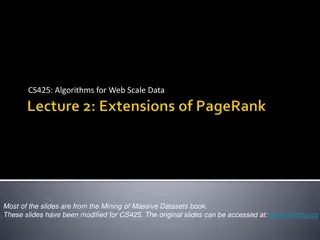
Introduction to Google PageRank and Eigenvector
Explore the concepts of Google PageRank, eigenvectors, stochastic matrices, and the Perron-Frobenius Theorem in this informative content. Understand how matrices play a crucial role in various applications and their diagonalizability implications.
Download Presentation

Please find below an Image/Link to download the presentation.
The content on the website is provided AS IS for your information and personal use only. It may not be sold, licensed, or shared on other websites without obtaining consent from the author. If you encounter any issues during the download, it is possible that the publisher has removed the file from their server.
You are allowed to download the files provided on this website for personal or commercial use, subject to the condition that they are used lawfully. All files are the property of their respective owners.
The content on the website is provided AS IS for your information and personal use only. It may not be sold, licensed, or shared on other websites without obtaining consent from the author.
E N D
Presentation Transcript
Google PageRank and Google PageRank and Eigenvector Eigenvector ( )
0.4 3 1 Stochastic Matrix 0.5 2 Consider 3 YouBike stations 1, 2, 3 on campus. Let ??,?be the probability that a bike rented at location will be returned to location . ?1,3: with prob. 0.5, bike at loc.3 will be returned to Loc. 1 0.3 0.3 0.4 0.4 0.4 0.2 0.5 0.3 0.2 ? = 10 5 8 Sum = 1 Day 0 , bike distribution ?0= Time 1 Time 2 Time 3 Time 4 Time 5 Steady state A?= ? ? A2?0 A3?0 A4?0 A5?0 A?0
0.3 0.3 0.4 0.4 0.4 0.2 0.5 0.3 0.2 ? = Stochastic Matrix A square matrix entries are nonnegative, and the sum of each column is 1. is positive of all of its entries are positive. FACT: If A is positive, 1 is an eigenvalue. ?? is stochastic of all of its ?? and ? have the same eigenvalues 0.3 0.4 0.5 0.3 0.4 0.3 0.4 0.2 0.2 1 1 1 1 1 1 =
0.3 0.3 0.4 0.4 0.4 0.2 0.5 0.3 0.2 ? = Stochastic Matrix FACT: If ? is an eigenvalue, |?| 1. ?1 ?2 ?3 ?1 ?2 ?3 0.3 0.4 0.5 0.3 0.4 0.3 0.4 0.2 0.2 =? Suppose |?2| is the max. among |?1|, |?2|, |?3| |?||?2| =|??2| = | 0.4 ?1+ 0.4 ?2+ 0.2 ?3| 0.4 |?1| + 0.4 |?2| + 0.2 |?3| 0.4 |?2| + 0.4 |?2| + 0.2 |?2| |?2| Hence, |?| 1
Diagonalizable Stochastic Matrix Diagonalizable Stochastic Matrix Eigenvectors ?1= 1 Eigenvalues 1 1 3/4 1/4 1/4 3/4 and ?2= and ? = 1 1 1/2 A(?1?1+?2?2) = ?1?1 + 1/2?2?2 A2(?1?1+?2?2) = ?1?1+ 1/4?2?2 A3(?1?1+?2?2) = ?1?1+ 1/8?2?2 An(?1?1+?2?2) = ?1?1+ 1/2??2?2 When ?is large, A?x approaches ?1?1, which is an eigenvector with eigenvalue 1.
Perron Perron Frobenius Frobenius Theorem Theorem Let a unique normalized steady state vector ?, which spans the 1-eigenspace. Moreover, for any vector ?0with entries summing to some number c, the iterates ?1= ??0?2= ??1 be a positive stochastic matrix. Then admits ??= ??? 1 approach c? as ? gets large.
Whether the matrix is diagonalizable or not, all vectors are sucked into the 1-eigenspace, which is a line. ??= ??? 1 https://services.math.duke.edu/~jdr/1819f-1553/materials/11-12-slides-blank.pdf
0.4 3 1 Stochastic Matrix 0.5 2 Steady state 7 6 5 0.3 0.3 0.4 0.4 0.4 0.2 0.5 0.3 0.2 Eigenvector ? = (1 18) ? = 0.39 0.33 0.28 Approx. It says that eventually 39% bikes will be in location 1, 33% will be in location 2, and 28% will be in location 3. If we start with 100 bikes, eventually we would have (39, 33, 28) bikes in the three locations.
The Most Valuable Eigenvector http://userpages.umbc.edu/~kogan/teaching/m4 30/GooglePageRank.pdf
PageRank PageRank is a numeric value that represents how important a page is on the web. Webpages with a higher PageRank are more likely to appear at the top of Google search results. Google interprets a link from page A to page B as a vote, by page A, for page B. If page A is more important itself, then the vote of A to B should carry more weight.
Importance hyperlink
Importance - Formulas ?1 ?3 ?1= ?3+1 2?4 3 1 ?2=1 3?1 ?3=1 3?1+1 2?2+1 2?4 1/2 2 4 ?4=1 3?1+1 2?2 1/2 ?2 ?4 Consider a random surfer
Importance - Formulas ?1 ?2 ?3 ?4 ?1= ?3+1 2?4 ? = ?2=1 3?1 ?? = ? ?3=1 3?1+1 2?2+1 2?4 The solution x is in the eigenspace of eigenvalue ? = 1 ?4=1 3?1+1 2?2
Importance - Formulas ?1 ?3 12 9 ?1 ?2 ?3 ?4 ? = 3 1 ?? = ? The solution x is in the eigenspace of eigenvalue ? = 1 ???? 12 2 4 ?2 6 4 ?4 6? 4 9
Eigenvalue = 1 ?? = ? Column-stochastic Matrix Column-stochastic matrix always have eigenvalue ? = 1 How about the Dangling nodes ( )?
Unique Ranking? ?1 ?3 12 9 3 1 Having eigenvalue ? = 1 If the dimension of the subspace is 1 2 4 Unique Ranking ?2 6 4 ?4 constraint Unique Score
Unique Ranking? How about dimension > 1 Dim for ? = 1 is 2 Basis: 0 0 1/2 1/2 1 3 1 3 0 0 5 5 1/2 1/2 2 2 0 0 4 4 Any linear combination is in the eigenspace Not Unique Ranking
Unique Ranking? How about dimension > 1 Dim for ? = 1 is 2 Basis: 0 0 1/2 1/2 1 3 1 3 0 0 5 5 1/2 1/2 2 2 0 0 4 4 Column-stochastic matrix and positive the dim of the eigenvalue ? = 1 is 1
1/? 1/? 1/? 1/? Can it be non- uniform? Unique Ranking? All entries are 1/n 0.15 Follow the link random There are two ways to surf the web Prob 1 m: Prob m: 1 3 1 3 5 5 2 4 2 4
Challenges Google s PageRank is an eigenvector of a matrix of order (in 2008) 10 n 12 The matrix A is sparse (tons of zeros) One way to compute the eigenvector x would be to start with a good approximate solution, such as the PageRanks from the previous month, and simply repeat the assignment .
Power method Start from ?0 1/? 1/? Find ? , such that ? = ?? ?0= M is very large all positive, sum to 1 ?1= ??0 If ? ?2= ??1 ??= ? ??= ??? 1
Actually The Last Toolbar Pagerank Update was December 2013 Google declared thereafter: PageRank is something that we haven t updated for over a year now, and we re probably not going to be updating it again going forward, at least the Toolbar version.

